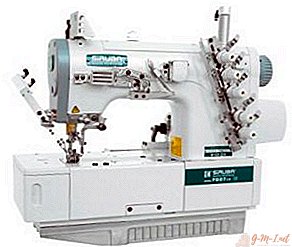Industrial sewing machines are designed to operate continuously for 12 hours or more daily. To optimize mass production, they are equipped with additional devices, such as automatic thread trimming, electronic foot raising.
How industrial equipment differs from household
Differences of factory equipment from home is as follows:
- functional, household sewing machines usually perform several types of stitches, and industrial narrowly targeted and designed to perform one operation;
- durability, the declared service life of home appliances is about 7 years with a small load, the service life of the production is about 10 years with constant work;
- speed, an industrial machine performs an average of 5000 thousand stitches per minute, domestic - 800 thousand;
- materials, household machines are suitable for working with light and medium - dense fabrics, while production machines differ in this.
Production are divided by work with materials into:
- Light and medium.
- Medium heavy.
- Heavy.
- Particularly heavy.
REFERENCE. A one-liner industrial machine can be reconfigured from one type of fabric to another by replacing a couple of parts.
Hardware Specification
Production sewing machines are capable of performing only one operation. Nowadays, to facilitate tailoring in mass production, many options have been invented with different functions, the most common of them:
 Single-needle lockstitch lockstitch machine - it is impossible to do without it in any studio;
Single-needle lockstitch lockstitch machine - it is impossible to do without it in any studio;- Overcasting or overlocking - the most common 51 classes, it is easy to operate and configure;
- Sewing (ploskoshovnaya) - used for sewing knitted fabrics;
- Special machine of the 26th class - makes a zigzag line of shuttle weaving;
- Buttonhole automatic machine or semiautomatic device.
There are a lot of manufacturers of industrial equipment, but the pros choose for quality and durability: Typical, Juki, Pfaff, Maxdo, Janome, Jaguar, Brothers.
IMPORTANT. You will find the best quality from European and Japanese manufacturers.
Selection tips
When choosing an industrial sewing machine, it is worth considering that the motor of such equipment for the home can be too noisy and the entire assembly is bulky. Before choosing a sewing machine, it is worth understanding that there are two types of engines:
- Friction operates at a constant frequency. It is not expensive, noisy, less powerful, it starts abruptly;
- Servo motor with electronic speed control. Expensive, silent, energy-saving, smooth start, powerful.
There are several types of fabric feed. It’s worth choosing depending on the direction of your activity.
- For work with knitted fabrics, differential feed using two sets of cloves is better.
- Needle feed is a good option for flashing multiple layers.
- Toothed rack is the most common mechanism, often giving an excessive landing of the lower layer.
- Working in the style of a patchwork, a walking foot will be indispensable, which will prevent the displacement and stretching of the layers.
REFERENCE. If the budget is limited, boldly buy used industrial machines, due to the high wear resistance with rare use, they will not use up their potential even in 10-15 years.


 Single-needle lockstitch lockstitch machine - it is impossible to do without it in any studio;
Single-needle lockstitch lockstitch machine - it is impossible to do without it in any studio;
Leave Your Comment